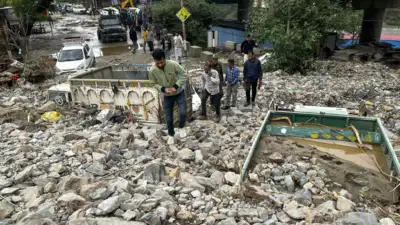Introduction
Recent days have brought a harsh reminder of nature’s power to the Ramban district in Jammu and Kashmir. Heavy rains caused landslides and floods that disrupted life and damaged infrastructure. These disasters hit hard, blocking roads, endangering lives, and shaking communities. What caused this chaos, and how can we prepare better? We’ll explore the reasons behind these calamities and what steps are needed to prevent future tragedies.
Overview of the Ramban District and Recent Disaster Events
Background on Ramban District
Nestled in the Himalayan mountains, Ramban spans lush forests and rugged slopes. Its high altitude and steep terrain make it prone to natural hazards. Summers bring heavy rains, and mudslides often follow. Over the years, this district has seen several floods and landslides that damage homes, roads, and crops. The area’s rich natural beauty comes with the risk of nature’s fury.
Recent Floods and Landslides: Overview
Just days ago, a powerful monsoon hit Ramban with relentless rain. Roads turned into rivers, and landslides buried sections of highways. Sadly, three people lost their lives, some due to falling debris and drowning. Rescue teams scrambled to free stranded villagers, clear blocked roads, and bring relief. The scene shows the fragile balance between nature’s beauty and its danger.
Causes and Contributing Factors of Landslides and Floods in Ramban
Geographical and Climatic Factors
The hilly terrain with steep slopes makes landslides a common sight here. Loose soil and rocks slide down during heavy rain. Monsoon storms dump large amounts of water in a short time, overwhelming rivers and causing floods. Climate change has made weather more unpredictable, increasing the chance of extreme events.
Human Activities Exacerbating Risks
Construction of roads and buildings on unstable slopes worsens the problem. Deforestation removes trees that hold soil together, leading to more slides. Mining and urban expansion often ignore natural risks. These activities disturb the land and push nature’s limits, making disasters more likely.
Impact of Climate Change
Rising temperatures change weather patterns. Monsoons become heavier, and rainfall occurs suddenly. The melt of glaciers adds to flood risks. Scientists warn that climate change will make such calamities more frequent and severe in places like Ramban.
Immediate Impact of the Disasters
Casualties and Human Loss
Three lives were lost during the recent landslides and floods. Many residents suffered injuries, and some couldn’t escape in time. Vulnerable groups like children and elders face higher dangers. The emotional toll on families and communities runs deep.
Damage to Infrastructure
Roads are broken or completely blocked. Bridges have collapsed, cutting off villages. Communication networks are down, delaying help. Local businesses and farms suffer, impacting livelihoods long term.
Emergency Response and Relief Measures
Rescue teams from the government and NGOs swung into action. They used helicopters, boats, and trained volunteers to reach stranded people. Temporary shelters are set up, and medical aid is on standby. The focus remains on saving lives and restoring essentials quickly.
Government and Community Response
Official Measures and Disaster Management
Local authorities issued warnings early to keep people safe. Rescue operations focused on the most affected areas. Relief supplies such as food and blankets are being distributed to stranded families. Efforts are also underway to assess damage and plan next steps.
Community Involvement
Local residents and volunteers played a big role in rescue efforts. Their quick action helped save many lives. Community leaders are also spreading awareness about safety during natural calamities. Together, the community and officials work to rebuild and recover faster.
Challenges Faced During Response
Blocked roads and rough terrain slowed down rescue teams. Limited resources and harsh weather added to difficulties. Coordinating efforts between agencies proved challenging but remains crucial for effective response.
Preventive Strategies and Long-term Mitigation
Terrain and Infrastructure Planning
Before building new roads or houses, geological surveys are essential. Putting in place disaster-resistant infrastructure can make a big difference. Proper planning reduces chances of landslides and floods damaging critical facilities.
Climate Adaptation Measures
Planting trees helps stabilize slopes and prevent erosion. Investing in early warning systems provides crucial seconds to evacuate when heavy rains speak of danger. Upgrading weather forecast technology improves preparedness.
Policy Recommendations
Laws should restrict risky land use in vulnerable areas. Communities need awareness programs on disaster preparedness. Local governments must enforce safety norms, ensuring safer growth for the future.
Real-World Examples and Lessons Learned
Other hilly regions face similar risks, like the Himalayan states or the hills of Northern India. In Uttarakhand, strict land use rules and early warning alerts helped prevent loss of life during heavy rains. Experts say better planning and community involvement save lives during disasters. Learning from these lessons can help Ramban and similar districts prepare smarter.
Actionable Tips for Residents and Authorities
- For residents: Keep an emergency kit ready. Know evacuation routes. Stay alert during heavy rain and landslide warnings.
- For authorities: Invest in better infrastructure. Implement early warning systems. Regularly check and improve disaster preparedness plans.
- For everyone: Join community awareness programs. Practice disaster drills. Knowledge saves lives when seconds count.
Conclusion
The recent disasters in Ramban remind us how fragile our environment can be. Heavy rains sparked floods and landslides, taking lives and destroying property. But we can do better. Proactive planning, smarter land use, and community effort can reduce risks. Everyone has a role—policymakers, volunteers, and residents alike. Moving forward, our focus must be on building safer communities resilient to nature’s unpredictable power. Only then can Ramban and similar regions protect their people and their future.

